|
Transportation Research Update
 POLICY AND PLANNING
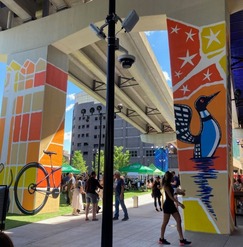
Historically disadvantaged communities have been impacted disproportionately by transportation infrastructure projects. To mitigate project impacts in the future, transportation agencies can involve these communities throughout the project’s planning process. Local artists and culture bearers are good candidates to serve as liaisons between transportation agencies and the community because they can offer creative placemaking ideas and represent the community’s interests.
This research project recommended a number of actions for implementation to ensure collaboration between transportation agencies and communities. The actions include developing a framework to better document the community engagement process to replicate successful processes, shifting the mindset about art as just an aesthetic outcome to incorporating arts and culture throughout the entire transportation planning process, providing regular and transparent information to communities throughout the process, and actively seeking artists and culture bearers to serve as creative contributors and liaisons to reach mutually beneficial outcomes for transportation agencies and the community.
|
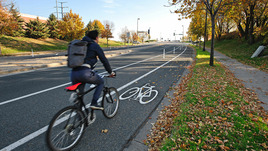
Constructing and maintaining safe road networks for bicyclists, pedestrians and other nonmotorized road users require knowing the numbers and destinations of these users. Accurately estimating the volume of these users has been challenging because monitoring methods are limited compared to vehicle traffic counters. Data from mobile devices, however, offers a potential source of traveler routes.
Researchers combined mobile data from existing platforms such as StreetLight and Strava with monitored bicyclist and pedestrian data to produce a data visualization tool that estimates bicyclist and pedestrian traffic within the Twin Cities metro area. Despite the inherent limitations of mobile data sources, such as inconsistent geographic coverage and demographic representation, MnDOT has begun using the visualization tool for approximations of bicyclist and pedestrian traffic in the Twin Cities area. Additional research is needed to improve the accuracy of the tool so estimates could support infrastructure decisions.
|
TRAFFIC AND SAFETY
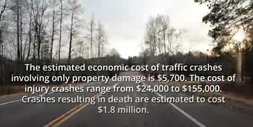
Substantial economic consequences from human injuries and property damage, in addition to social and environmental costs, result from deer-vehicle collisions. While MnDOT uses fencing and other safety measures to keep deer off the roads, knowing the areas where these and other barriers would be most effective is dependent on numerous factors. For example, many collisions go unreported, so the extent of the issue remains unknown. New tools, data and methods for identifying at-risk locations and estimating unreported collisions have been devised to help guide the agency in minimizing deer-vehicle collisions.
Investigators drove 1,000 miles per month in a defined area for more than 18 months to collect data from the aftermath of deer-vehicle collisions. Comparing that data to accident reports showed that only one in four accidents is reported. Then, combining multiple data sets on collisions, road characteristics, land cover and other variables assisted in explaining what factors correlate with an increased risk of deer-vehicle collisions. A mapping tool fueled by a machine-learning model will help MnDOT identify the deer-vehicle collision risk on any road segment in Minnesota so that engineers can implement safety measures where they are most effective.
Watch this video to learn more about deer-vehicle collisions. 🦌🚖
|

Preventing right turns on red at signalized intersections with fixed No Right Turn on Red (NRTOR) signs can protect pedestrians trying to cross the street. If no pedestrians are present, however, preventing right turns can impede traffic. Dynamic signs that can be activated by pedestrians or at certain times of the day offer a potential solution. MnDOT wanted to compare the effectiveness of dynamic and static NRTOR signs in encouraging driver compliance.
Researchers analyzed over 4,500 hours of video data from intersections with either dynamic or static signs preventing right turns on red at traffic signals. Dynamic signs were not more effective than static signs at increasing the number of drivers not turning right on red. However, adding a dynamic sign to an intersection without any sign appeared to increase pedestrian visibility to drivers. Most drivers not complying with the dynamic signs made right turns after pedestrians crossed the road. Finally, a NRTOR sign activated by time of day demonstrated a clear traffic flow benefit.
|
MATERIALS AND CONSTRUCTION
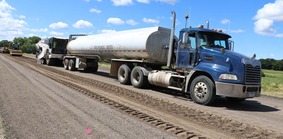
Weak or vulnerable soils can decrease the strength of a road pavement base. New research illustrates proprietary base stabilization additives could provide stronger, more durable pavements.
Laboratory and field testing over two years allowed researchers to determine optimal application rates and design specifications for using stabilizing additives in certain road reconstruction methods. Five pavement test sections compared different stabilizing products and a section without base stabilizer. Performance monitoring and an economic analysis showed the stabilized pavement sections were stronger after two years and were estimated to have lower overall life cycle costs. New pavement design standards incorporating these results can support more sustainable, cost-effective roads.
|
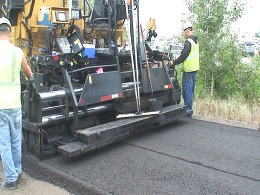
Cold-recycling processes such as Cold in Place Recycling (CIR) and Cold-Central Plant Recycling (CCPR) offer opportunities for innovation through the use of recycling additives (RAs). The objective of this project was to evaluate the efficacy of rejuvenating asphalt emulsions in the CIR and/or CCPR process in terms of potential performance benefits relative to existing stabilization options. An experimental matrix was designed to include several of the mix design factors known or thought to control mix performance. Rejuvenating asphalt emulsions containing both Bio-based and petroleum-based RAs were produced and compared to a control engineered emulsion with a proven field history of performance. Inclusion of RAs did not negatively impact mixture stability or the mechanism of strength, while generally improving the CT Index of the tested cold recycled mixes compared to the use of a similarly graded control emulsion.
The concept of utilizing a “Balanced Mix Design” approach was explored to quantify the performance attributes of these materials. Mixture stability at 40 °C and mixture IDEAL CT Index at 25 °C were ultimately selected as the performance tests used in the balanced mix design framework. To aid rapid implementation of the results, the recommendations were also written in the form of a specification amendment document, included in the appendix of this report.
|
UPCOMING EVENTS

|
|
If you need an ASL, a foreign language interpreter, or documents in an alternative format please contact Janet Miller at 651-366-4720 (711 or 1-800-627-3529 for MN Relay). If you need any other reasonable accommodation to participate, please email your request to ADArequest.dot@state.mn.us. |
|
|
|